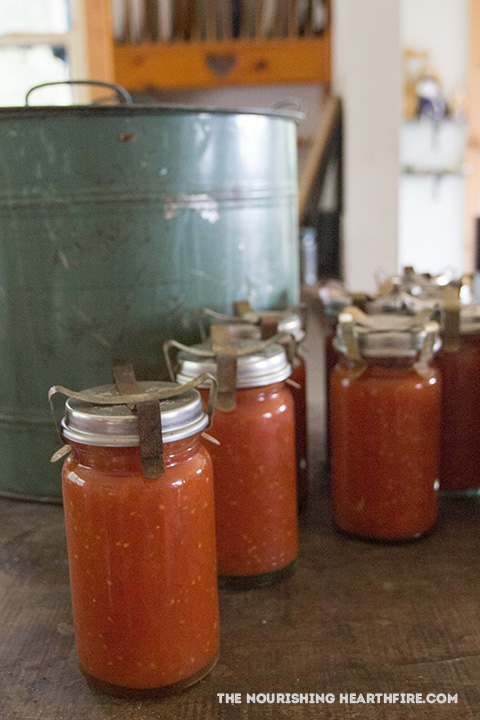
Sometimes it’s hard to feel anything but angry about the current state of things, but there are lots of positive actions that can be done that boost personal resilience and wellbeing as well as reducing ecological footprints.
There’s a new book all about this, currently on Kickstarter here. My new book ‘Backyard Dairy Goats‘ is included as a stretch goal on it!
Preserving tomatoes at home
This year I did something I’d been thinking about for a long time. I bottled our entire tomato supply for the year…
I’d delayed this in the past due to annoying finicky instructions that insist on peeling the tomatoes, removing seeds, putting them through an expensive single-purpose gadget, and all kinds of stuff, but in the end I thought it was about time I tried this myself, using nothing more than a kitchen knife.
Our own garden harvest was not that big this year, for a few reasons that I’ve hopefully learned from, but rather than buying in bottled tomatoes from the other side of the world, I found a local organic grower, bought more than 30kg of sauce-grade tomatoes and bottled them all.
This is how we did it:
Step 1:
This step is only worth doing if you have too many tomatoes to fit in your pot at once. Sort through all the tomatoes and separate the damaged and super-ripe ones from the ones that can wait for a bit longer. Put the ones that can wait aside for another day (we preserved our 30kg+ of tomatoes over 3 days).
Step 2:
Wash the tomatoes, remove any leaves and stems (this is a good job for little helpers).
Step 3:
Roughly chop the tomatoes and put them in a big stainless steel pot (I used my 20 litre one).
Step 4:
Heat the chopped tomatoes over medium-high heat, smashing them up as you stir every so often. Once the tomatoes are bubbling you can either bottle them now, or reduce them for a bit. The jars I used were a bit smaller than the passata bottles I’m used to, so I chose to boil them to reduce them by around 1/4 to 1/3, to make for a more concentrated jar of tomato goodness. If you’re using plum tomatoes or paste tomatoes you’re more likely to get away with boiling them for less time, but ‘sauce tomatoes’ here just means any tomatoes that aren’t quite perfect, so they can use a bit of boiling to get rid of the extra liquid.
While you’re waiting for the tomatoes to heat up or reduce, sterilise your jars and lids and keep them warm.
Step 5:
If you’re concerned about the tomatoes not being acidic enough on their own to store safely, then add a tablespoon of cider vinegar or lemon juice to each 500-600ml jar, or 2 tablespoons to larger jars.
Put the hot tomatoes in the warm jars and seal them with their clips or rings, depending on which jar type you’re using. Put a big canning pot with a false bottom or canning rack on the stove (or use a tea towel or some cutlery at the bottom of a normal pot), put a small amount of warm water in it (so that the hot jars aren’t shocked by a sudden change of temperature), then carefully add your jars. Add more water, so that the jars are surrounded by water either to just above the top of the lid, or at least 3/4 of the way up.
Put the lid on the pot and bring it to the boil, or at least above 90ºC (195ºF). Hold it at this temperature for 40-45 minutes, then allow the pot to sit with the lid off for 5 minutes. Carefully remove the jars using a jar lifter and allow them to cool on the bench before storing.
Fill up the next batch of jars for the pot and repeat until you’ve run out of hot tomatoes, making sure that the water in the pot at the beginning is around the same temperature as the jars. You can do this over two or more days, as long as the tomatoes are brought to the boil and kept hot for a while before bottling, and put into hot sterilised jars.
The result:
Bottling my own tomatoes at home has reduced the amount of far-away foods in our diet, reduced our tomato costs by half, made us more resilient, reduced waste, and they taste better than factory-bottled ones. It was an enjoyable time with family, with all of us appreciating the process and the results.